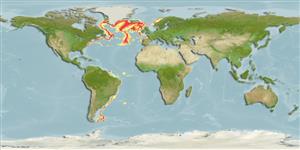Preferred temperature (Ref.
123201): 3.3 - 4.3, mean 3.5 °C (based on 57 cells).
Índice de diversidade filogenética (Ref.
82804): PD
50 = 0.5000 [Uniqueness, from 0.5 = low to 2.0 = high].
Bayesian length-weight: a=0.00282 (0.00118 - 0.00673), b=3.10 (2.89 - 3.31), in cm total length, based on LWR estimates for this (Sub)family-body shape (Ref.
93245).
Nível Trófico (Ref.
69278): 4.3 ±0.41 se; based on food items.
Resiliência (Ref.
120179): Baixo, tempo mínimo de duplicação da população 4,5 - 14 anos (Assuming Fec <100).
Fishing Vulnerability (Ref.
59153): Very high vulnerability (78 of 100).
Nutrients (Ref.
124155): Calcium = 8.44 [2.45, 28.17] mg/100g; Iron = 0.345 [0.115, 0.914] mg/100g; Protein = 16.1 [10.5, 19.1] %; Omega3 = 0.299 [0.107, 0.829] g/100g; Selenium = 23.6 [7.3, 77.0] μg/100g; VitaminA = 5.7 [1.2, 25.5] μg/100g; Zinc = 0.265 [0.133, 0.516] mg/100g (wet weight); based on
nutrient studies. 